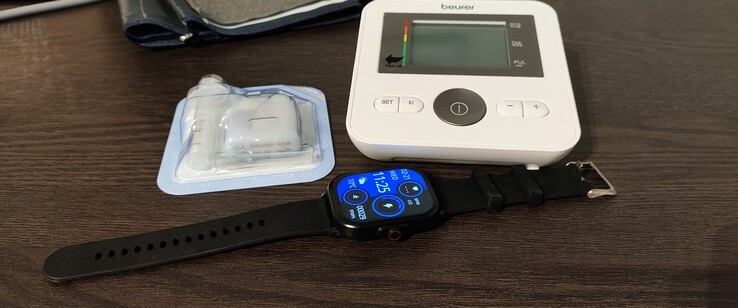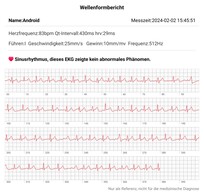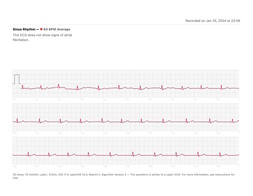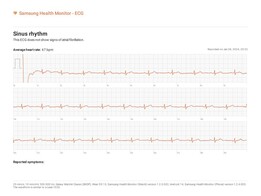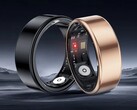Blood pressure, blood sugar and ECG: Background and review of the iHEAL 6 - A potential health hazard
The iHEAL 6 is advertized by Kospet as having an enormous range of functions. In this article, we will be taking a critical look at its advertizing promises—with the help of medical measuring devices and not without restrictions.
March 01, 2024 update: Kospet has reached out to us to state that it has stopped the production of the iHeal 6.
Optical measurement of blood pressure and blood sugar isn't impossible
Blood glucose levels and blood pressure can—in principle—be determined photometrically. This allows the interaction between glucose and electromagnetic waves to be detected and the glucose content of a solution to be measured accordingly. In a laboratory environment, glucose is often measured using a photometer after an enzymatic conversion. The optical measurement of blood pressure is possible with several Galaxy smartwatches from Samsung, but requires a support calibration.
The Kospet iHEAL 6's advertized features are therefore not physically impossible. However, optically measuring blood glucose levels—especially without the need for calibration—is in some ways a holy grail. This would be the first practical, non-invasive method for measuring blood glucose levels and as no consumables in the form of blood glucose test strips or pods would be required, this would result in considerable cost savings. On the other hand, the fact that this function is to be provided by affordable smartwatches from the Far East in particular is a cause for concern.
ECG measurement using wearables is established
Several wearables—including the Apple Watch—support ECG creation. This may only be a single-channel ECG, but it can already detect certain irregularities in the heart. Their measurement principle is in some ways more direct than optical measurement, as the heart currents are measured. In the medical field, a 12-lead ECG is often used due to its greater informative value.
About readings and blood pressure
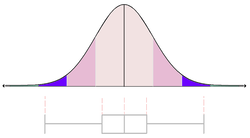
The nature of the measured values must be taken into account when classifying them. Measured values do not represent the true values, which, as a rule, can hardly be determined with certainty—unless, for example, a comparative sample (also subject to uncertainty) is spiked in the laboratory environment. A measured value without an indication of the measurement accuracy is acceptable in everyday life in many cases—for example when measuring furniture—but in the worst case, it is worthless in a medical or chemical-analytical environment. The measurement deviation as a parameter indicates the deviation of a measured value from the true value. The measurement accuracy can be specified as the range around a measured value in which the true value is located with a certain probability. The meaning of these parameters can be explained using an example: If a delivery of a material with a purity of 85 per cent has been agreed to and a content of 84 per cent is then measured using a method with a measurement uncertainty of 2 per cent, it is difficult to make a complaint on the basis of this measurement.
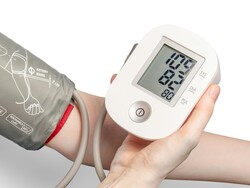
The BM27 blood pressure monitor we used as a reference has a measurement uncertainty of 8 mmHg for systolic and diastolic blood pressure. Knowing the reference device's measurement uncertainty is also relevant for evaluating how accurately the smartwatch that we tested can measure: Even if the readings between the blood pressure monitor and the smartwatch differ by 15 mmHg, this does not necessarily speak against the smartwatch. In the worst case, the reference device's blood pressure measurement could, for example, be at the lower end of the acceptable measurement deviation and the smartwatch at the upper end—and still not deviate from the true value by more than 8 mmHg in each case.
Blood sugar measurement is only ever accurate to a limited extent
The same applies to measuring blood glucose levels. The corresponding DIN EN ISO standard 15197:2015 requires a maximum deviation of 0.8 mmol/l from the true value for measured values below 5.6 mmol/l; for values above 5.6 mmol/l, the deviation may then be up to 15 per cent. 95 per cent of the measured blood glucose values must be within this range. We used approved FreeStyle blood glucose meters as reference devices and an Omnipod 5 for the longer measurement. The measurement was carried out on two different people, whereby both physiological ("normal") and pathological ("abnormal") measured values were available to us for the test to assess the watch's measuring accuracy. The inclusion of a diabetic person is practically mandatory: blood glucose levels are regulated within narrow limits in metabolically healthy people and don't normally reach values above 7.8 mmol/l. Accordingly, a watch that displays random values in the normal range without actually measuring is "correct" with a high degree of accuracy in metabolically healthy people.
Evaluation of the ECG is only possible to a limited extent
Evaluating the quality of the integrated ECG is also not trivial—plus, we can only do this to a limited extent. At this point, the metrological recording of the ECG must be separated from the computer-aided, automatic evaluation of the electrocardiogram. We can evaluate the recording. The iHEAL 6 can also display the ECG graphically if required. With prior medical knowledge, we can recognize whether what's being displayed is appropriate. We are also able to check its accuracy: we have a professionally produced ECG of the same person available for comparison.
If, for example, (hopefully only) physiological abnormalities can be identified in both the display generated by the watch and the printout of the professional ECG, this is a very strong indication that the iHEAL 6 can actually produce a suitable ECG. It should be noted that this is only a 1-channel ECG with limited informative value, which represents lead I according to Eindhoven when worn normally. However, we cannot evaluate whether the watch draws the right conclusions: We simply don't have a test subject with cardiac arrhythmia, for example.
It should also be mentioned at this point that we have refrained from conducting a detailed evaluation of the system as a smartwatch. In our extensive tests, however, the watch proved to be a bright, well-made watch that is free of design flaws.
The advertized blood glucose measurement fails completely
The iHEAL 6 is advertized as featuring a blood glucose level measurement function. We have already mentioned this in our news article: The blood glucose curve seemed a little atypical to us, and the test revealed that the iHEAL 6 is not actually able to measure blood glucose levels at all. As already described, the measurement is only inadequate for checking the quality in the physiological range, whereas pathological readings show a huge deviation.
| iHEAL 6 | Dexcom | Measurement strips |
| All figures in mmol/L | ||
| 5.7 | 10.4 | 8.8 |
| 7 | 2.3 | 3.8 |
It is clear that the iHEAL 6 can detect neither hypoglycemia nor hyperglycemia. In the case of hypoglycemia, it even displays a higher value than in the case of hyperglycemia; all values generated by the iHEAL 6 during the test were within the normal range. For type 1 diabetics, using the iHEAL 6 is potentially life-threatening if they rely solely on the watch and, for example, hypoglycemia is detected too late. As a result, patients with type 2 diabetes may be lulled into a false sense of security—which can lead to long-term damage.
Blood pressure measurement is also disappointing
The ability to measure blood pressure is also advertized by the manufacturer. Optically measuring blood pressure could in principle be useful both for monitoring the progress of widespread hypertension in particular and for screening and—as a continuous measurement—could detect blood pressure peaks, for example. However, the iHEAL 6 is not able to generate accurate measured values.
| iHEAL 6 | Beurer BM27 | ||
| All figures in mmHg | |||
| systolic | diastolic | systolic | diastolic |
| 117 | 78 | 140 | 75 |
| 127 | 84 | 131 | 72 |
| 117 | 78 | 150 | 69 |
The values shown in the last line are particularly striking. There, the difference in systolic pressure is 33 mmHg. The iHEAL 6 still shows optimal blood pressure here, while the certified measuring device already shows mild hypertension. As with blood glucose measurement, the iHEAL 6 only displays physiological readings when measuring blood pressure.
A manual, tenfold measurement using the iHEAL 6 resulted in a mean value of 117.9 mmHg for systolic blood pressure—with a relative standard deviation of only 2.5 per cent. This means that the measured values are very precise, but precisely incorrect and therefore not accurate, as the reference value generated by the measuring device was 150 mmHg.
ECG: Works and is quite accurate
In turn, the iHEAL 6's ECG function is decent. The ECG has sufficient resolution to show all the features of a typical electrocardiogram, including the P wave and ST segment. In a visual comparison with ECGs produced by the Apple Watch and the Samsung Galaxy Watch 4 Classic, there is definitely no poorer readability. We were able to verify the objective accuracy of the recording by comparing it with the first lead of a professionally prepared ECG. With a little acrobatics, it is even possible to produce other leads by pressing the watch against the left leg, for example. As already described, we cannot assess the computer-aided, automatic evaluation in the absence of a corresponding test subject.
Verdict: Audacious advertizing claims and a proper ECG
The iHEAL 6 is advertized as having a virtually ground-breaking range of functions—and in practice is a potential health hazard. According to our analysis, neither its blood pressure measurement nor its blood glucose level measurement works as advertized, which can lull customers into a false and fatal sense of security as only physiological readings are displayed. The ECG function, on the other hand, is decent—at least the recording we were able to evaluate.
Disclosure: The author was supported in their evaluation of the ECG function by a cand. med. and doctoral student of medicine.
Price and availability
The iHEAL 6 can be purchased directly from the manufacturer for around US$50. An alternative with a blood pressure measurement function featuring support calibration and a certified ECG would be the corresponding Galaxy Watch models from Samsung.
Transparency
The selection of devices to be reviewed is made by our editorial team. The test sample was provided to the author as a loan by the manufacturer or retailer for the purpose of this review. The lender had no influence on this review, nor did the manufacturer receive a copy of this review before publication. There was no obligation to publish this review. As an independent media company, Notebookcheck is not subjected to the authority of manufacturers, retailers or publishers.
This is how Notebookcheck is testing
Every year, Notebookcheck independently reviews hundreds of laptops and smartphones using standardized procedures to ensure that all results are comparable. We have continuously developed our test methods for around 20 years and set industry standards in the process. In our test labs, high-quality measuring equipment is utilized by experienced technicians and editors. These tests involve a multi-stage validation process. Our complex rating system is based on hundreds of well-founded measurements and benchmarks, which maintains objectivity. Further information on our test methods can be found here.
Source(s)
Photo by Mockup Graphics via Unsplash, photo by Elias Tsolis via Pixabay




